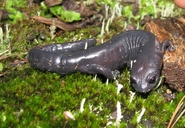|
Bolitoglossa tenebrosa Vazquez-Almazán & Rovito, 2014
Guatemalan Black Salamander; Salamandra Negra Guatemalteca Subgenus: Magnadigita | family: Plethodontidae subfamily: Hemidactyliinae genus: Bolitoglossa |
| Species Description: Vasquez-Almazan CR, Rovito SM 2014 A new species of Black Bolitoglossa (Caudata: Plethodontidae) from Guatemala. J Herptol 48: 518-524. | |
 © 2009 Carlos R. Vasquez-Almazan (1 of 4) |
|
|
|
Description In life, this species is solid black on its head, tail, and dorsal surface of its body. From a ventral view, it is light grey. In a preservative, the dorsal view of the body, head, tail, and limbs are dark grey. However, the upper surface of the feet is light grey-brown. From a ventral view, the body appears light grey with the intersection of the forelimbs looking light brown. There is a light brown color at the throat with a light streak of light grey going across behind the gular fold. The bottom of the tail is also light grey while the bottom of the limbs and phalanges are light grey-brown (Vásquez-Almazán and Rovito 2014). The external features, specifically dark coloration, of species within Bolitoglossa (subgenus Magnadigita) have made individual identification and separation difficult. Like other species of Bolitoglossa, B. tenebrosa does not have a sublingual fold. The reduced toe and finger webbing as well as genetic information assigned it to the subgenus, Magnadigita. Moreover, its lack of fully webbed feet differentiates it from members of the subgenera Bolitoglossa, Nanotriton, Pachymandra, and Mayamandra. This species differs from Eladinea and Oaxakia due to genetic differences as well as the presence of a first caudal vertebra with branched transverse processes. Unlike all species within its subgenus except for B. meliana, this species has no spots or color. Its larger size also distinguishes it from B. omniumsanctorum, B. lincolni,and B. franklini. While both B. tenebrosa and B. meliana are the same uniform black color, B. tenebrosa males and females both have longer tails and broader heads, and also have more maxillary and vomerine teeth. Its longer tail length also differentiates it from B. tzultacaj (Vásquez-Almazán and Rovito 2014). In life, this species is solid black on its head, tail, and dorsal surface of its body. From a ventral view, it is light grey. In a preservative, the dorsal view of the body, head, tail, and limbs are dark grey. However, the upper surface of the feet is light grey-brown. From a ventral view, the body appears light grey with the intersection of the forelimbs looking light brown. There is a light brown color at the throat with a light streak of light grey going across behind the gular fold. The bottom of the tail is also light grey while the bottom of the limbs and phalanges are light grey-brown (Vásquez-Almazán and Rovito 2014). Other than measurements, there is no information available on variation within the species (Vásquez-Almazán and Rovito 2014). Distribution and Habitat Country distribution from AmphibiaWeb's database: Guatemala
Life History, Abundance, Activity, and Special Behaviors Trends and Threats Possible reasons for amphibian decline General habitat alteration and loss Comments Despite its similar morphology, molecular data do not support that B. tenebrosa is a sister taxon to B. meliana. Instead, molecular data suggest that this species is a distinct species in subgenus Magnadigita (Vásquez-Almazán and Rovito 2014). The epithet tenebrosa comes from a Latin root meaning “dark” which refers to both the black coloration as well as the problem of this species being misidentified for many years as B. meliana (Vásquez-Almazán and Rovito 2014).
References
Vasquez-Almazan, C. R., Rovito, S. M. (2014). ''A New Species of Black Bolitoglossa (Caudata: Plethodontidae) from Guatemala.'' Journal of Herpetology, 48, 518-524. [link] Originally submitted by: Jennie Mook (first posted 2015-06-17) Edited by: Gordon Lau (2015-06-28) Species Account Citation: AmphibiaWeb 2015 Bolitoglossa tenebrosa: Guatemalan Black Salamander; Salamandra Negra Guatemalteca <https://amphibiaweb.org/species/8295> University of California, Berkeley, CA, USA. Accessed May 12, 2025.
Feedback or comments about this page.
Citation: AmphibiaWeb. 2025. <https://amphibiaweb.org> University of California, Berkeley, CA, USA. Accessed 12 May 2025. AmphibiaWeb's policy on data use. |



 Map of Life
Map of Life